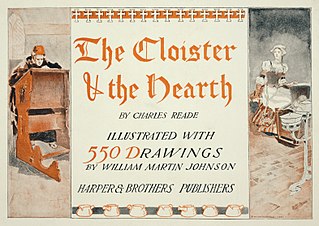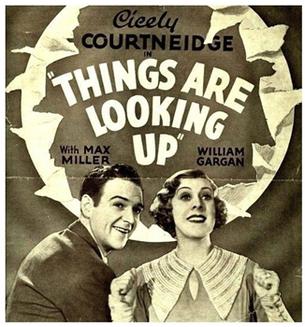Related Research Articles

Worcester Cathedral, formally the Cathedral Church of Christ and Blessed Mary the Virgin, is a Church of England cathedral in Worcester, England. The cathedral is the seat of the bishop of Worcester and is the mother church of the diocese of Worcester; it is administered by its dean and chapter. The cathedral is a grade I listed building and part of a scheduled monument.

Boys Will Be Boys is a 1935 British comedy film directed by William Beaudine which stars Will Hay, Gordon Harker and Jimmy Hanley. The film is set at Narkover School, where headmaster Doctor Alec Smart becomes involved in the disappearance of a valuable necklace.

The Cloister and the Hearth (1861) is an historical novel by the British author Charles Reade. Set in the 15th century, it relates the travels of a young scribe and illuminator, Gerard Eliassoen, through several European countries. The Cloister and the Hearth often describes the events, people and their practices in minute detail. Its main theme is the struggle between man's obligations to family and to Church.

The Midshipmaid is a 1932 British comedy film directed by Albert de Courville and starring Jessie Matthews, Frederick Kerr, Basil Sydney and Nigel Bruce. The film is based on the 1931 play of the same title by Ian Hay and Stephen King-Hall. it was released in the U.S. as Midshipmaid Gob. John Mills makes his film debut in a supporting role. It was shot at the Lime Grove Studios, with sets designed by the art director Alfred Junge.
Deadlock is a 1931 British crime film directed by George King and starring Stewart Rome, Marjorie Hume and Warwick Ward. It is on the British Film Institute's list of the 75 Most Wanted list of lost films.

The Sacred Flame is a 1929 film directed by Archie Mayo, starring Pauline Frederick and Conrad Nagel, and based on a 1928 Broadway play of the same title by Somerset Maugham. It is now considered a lost film. Two years later Warner Brothers remade the film in German The Sacred Flame. In 1935, a second remake The Right to Live, was made, starring Colin Clive and George Brent.
Edward Hay-Plumb was an English actor and film director.
Hepworth Picture Plays was a British film production company active during the silent era. Founded in 1897 by the cinema pioneer Cecil Hepworth, it was based at Walton Studios west of London.
The Grand Babylon Hotel is a 1916 British silent thriller film directed by Frank Wilson and starring Fred Wright, Marguerite Blanche and Gerald Lawrence. It is an adaptation of the 1902 novel of the same title by Arnold Bennett.

Things Are Looking Up is a 1935 British musical comedy film directed by Albert de Courville, produced by Michael Balcon for Gaumont British and starring Cicely Courtneidge, Max Miller and William Gargan. It was made at Islington Studios by British Gaumont, an affiliate of Gainsborough Pictures. The film's sets were designed by Alex Vetchinsky. The film was distributed by Gaumont British Distributors.
Sheba is a 1919 British silent drama film directed by Cecil M. Hepworth and starring Alma Taylor, Gerald Ames and James Carew. The film is notable for an early appearance of Ronald Colman in a small part. It was made by Hepworth Pictures at Walton Studios.
The Man Who Stayed at Home is a 1915 British silent thriller film directed by Cecil M. Hepworth and starring Dennis Eadie, Violet Hopson and Alma Taylor. It is based on the play by Lechmere Worrall and J. E. Harold Terry.
Sowing the Wind is a 1916 British silent romance film directed by Cecil Hepworth and starring Henry Ainley, Alma Taylor and Stewart Rome. It is based on the play Sowing the Wind by Sydney Grundy.
Molly Bawn is an 1878 novel by the Irish writer Margaret Wolfe Hungerford. In 1916 it was adapted into a silent film of the same title starring Alma Taylor. The novel is the origin of the expression "Beauty is in the eye of the beholder".
Molly Bawn is a 1916 British silent drama film directed by Cecil M. Hepworth and starring Alma Taylor, Stewart Rome and Violet Hopson. It is an adaptation of the 1878 Irish novel Molly Bawn by Margaret Wolfe Hungerford.
The Heart of Midlothian is a 1914 British silent historical film directed by Frank Wilson and starring Flora Morris, Violet Hopson and Alma Taylor. It is an adaptation of Sir Walter Scott's 1818 novel The Heart of Midlothian.

Alec Worcester (1887–1952) was a British stage and silent film actor. He played the lead role opposite Alma Taylor in The Cloister and the Hearth and was the lead in fifty shorts. He was married to the actress Violet Hopson until their divorce in 1919.
Justice is a 1914 British silent crime film directed by Frank Wilson and starring Alec Worcester, Alma Taylor and Stewart Rome.
Iris is a 1916 British silent romance film directed by Cecil M. Hepworth and starring Henry Ainley, Alma Taylor and Stewart Rome. It is based on the 1901 play Iris by Arthur Wing Pinero.
Shadows of a Great City is a 1913 British silent crime film directed by Frank Wilson and starring Alec Worcester, Chrissie White and Harry Royston. It is an adaptation of the 1884 play The Shadows of a Great City by Herbert Blaché and Aaron Hoffman. An American film adaptation was made two years later.
References
- ↑ Goble p.384